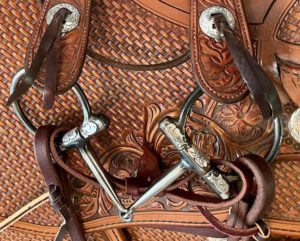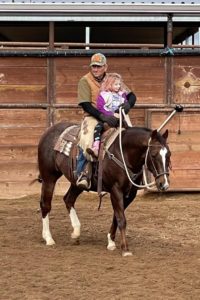
The exquisite craftsmanship is evident in Randy Paul’s bits.
There’s a reason an entire sport has developed from a bit.
“The snaffle bit, for me, is probably one of the most important pieces of equipment we have. I start all my horses in a snaffle and I think my main purpose is layering that foundation on them. It’s a direct pull. When I teach a horse to be soft, get the foundation going, teach them how to follow their nose and keep their feet connected to their nose, it’s going to last them through every piece of equipment I put on them,” $1.1 million earner Phillip Ralls said.
Like Ralls said, the snaffle bit is foundational. But how deeply do people think about and understand its purpose in the training of a cow horse? To help clarify this process, we spoke with Ralls and trainer Randy Paul in detail about their approach to the snaffle bit in their program. Both trainers believe getting a horse truly broke in a snaffle is crucial for the rest of it’s cow horse career. Around four or five years old the horses move onto a hackamore. There is a progression in the training with the end goal of creating a bridle horse.
Ralls said the goal is no gimmicks, no games, just focus on getting the horse broke in the snaffle bit. Randy Paul is an NRCHA $522,165 earner and has won $1 million in the NRHA. He is also a bit maker. He doesn’t have a website but his bits are a favorite among the cow horse community.
There are so many different options out there for bits. Paul said there isn’t much to invent, as it’s probably been made already.
“You’re training him when he is three to be a good horse when he’s 10,” Paul said. That foundation begins in the snaffle bit.
“I always try to think about the snaffle working on the corners of their mouth,” Ralls said. “If you’re using a D-ring snaffle you’re going to get a little pressure on the outside of the cheek which can be helpful,” Ralls said. In Ralls’ program, every horse gets started in a smooth snaffle and they stay in it for a while.
Paul will teach the horse to give right and left in a snaffle bit before he teaches them to bridle up. Like Ralls, Paul said he will typically ride a horse in a smooth snaffle for a while unless they tend to be tough mouthed.
“I think almost every horse outgrows the smooth snaffle…I usually go to a pretty average twisted wire snaffle and progress to a smaller diameter twist…. The more bite a snaffle has the [more gentle] you want to be and let the bit do the work… As soon as they get heavy in the smooth snaffle I go to the twist,” Paul said.
“If they’re thinking the right way and I can get their mind right, it’s not because of what snaffle I have on them. It’s because I have them thinking properly and understanding where they need to go,” Ralls said.
He said some horses can be tough-minded and they will need to go in different snaffles along the way.
The top four snaffles Ralls uses the most are a smooth loose ring snaffle, D-ring with a fat twisted wire, a square loose ring, and a D-ring with a smaller twist. Ralls prefers the snaffles that are broken in the middle once as opposed to the dog bone snaffles. He likes the way they feel in the horse’s mouth and it works for his program.
Paul most often uses a bit he calls an alligator. “It’s basically a smooth snaffle with some notches cut in it… It’s more bite than a smooth snaffle bit but less bite than a slow twist.”
“If I’m struggling with a spot [I won’t] go back to the tack room and get a bigger [bit]. It’s usually that I need to slow down and find that spot [and] find the piece I’m missing,” Ralls said.
It’s important with the sensitive horses to make sure they are in a bit that they are confident in. 

“Some of these studs and geldings that are on the lazy or numb side, I will put a little more snaffle on them so I don’t have to use it…If the horse wants to be numb, I don’t want to put something on them that they feel like they can lean on. I’ll put more snaffle on them and have them to where they stay off of it,” Ralls said.
“Their natural instinct is to lean on pressure…The whole foundation we’re putting on them is to get off of pressure whether it’s the leg or [in the mouth],” Paul said.

“If you pull one rein they just keep finding the center of the hackamore with their head. And go wherever that hackamore is going. It’s a neat art. There have been some great hackamore guys over the years,” Paul said.
Ralls doesn’t even want to get to the stage where he has to get tough with a numb horse. It’s better in that case to go up in bit. Maybe some days the horse comes out numb and stiff so for a few days Ralls will ride in more bit and then go back to a lesser bit.
“Trying to create a soft mindset is very important. Not trying to teach them that they’re going to be competitive in any piece of equipment I put on them because then it won’t matter. Eventually you won’t have enough bridles. I really try to eliminate the competitiveness with me and try to have that directed at the cow,” Ralls added.
In cow horses, there is a progression of training and progression of equipment. The horse will go in the snaffle bit, then hackamore if suitable, then the two-rein and finally go on to be a bridle horse. Ralls will ride his horses in the snaffle a majority of their two and three year old years. Once they turn four, he will start putting a hackamore on them.
Paul said he shows the cow horses in a smooth snaffle when they are three and four years old and then at five years old they will start in the hackamore in his program. The horses have to be shown in a smooth snaffle when they show in a snaffle bit.
To progress to the hackamore, Ralls will start them in a loping hackamore because it helps take their nose left and right more. Then when ridden in the show hackamore they get the basic idea.
The hackamores don’t have many different options to choose from. The difference is mostly in how soft or firm the nose piece is.
Paul said,“for some horses [the snaffle to hackamore] is a big jump. Regardless of the horse there is a process. You have to teach the horse how to find the center of the hackamore and take a pull on a hackamore correctly…A lot of the time they feel great in it when you first put it on and then as you ride them in it, they tend to fall apart. You have to take your time to train them in it.”
“If you pull one rein they just keep finding the center of the hackamore with their head. And go wherever that hackamore is going. It’s a neat art. There have been some great hackamore guys over the years,” Paul said.
Watch Randy Paul’s RCHTO Videos Here
